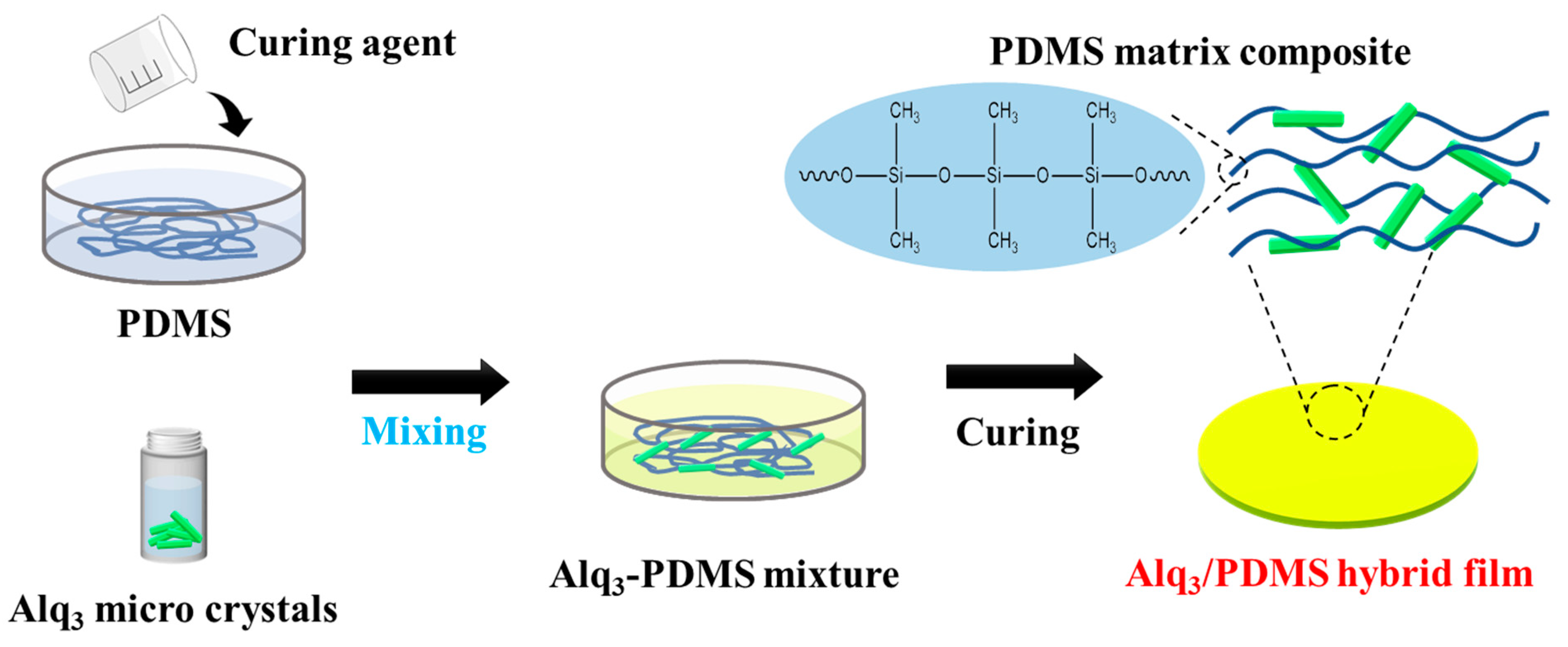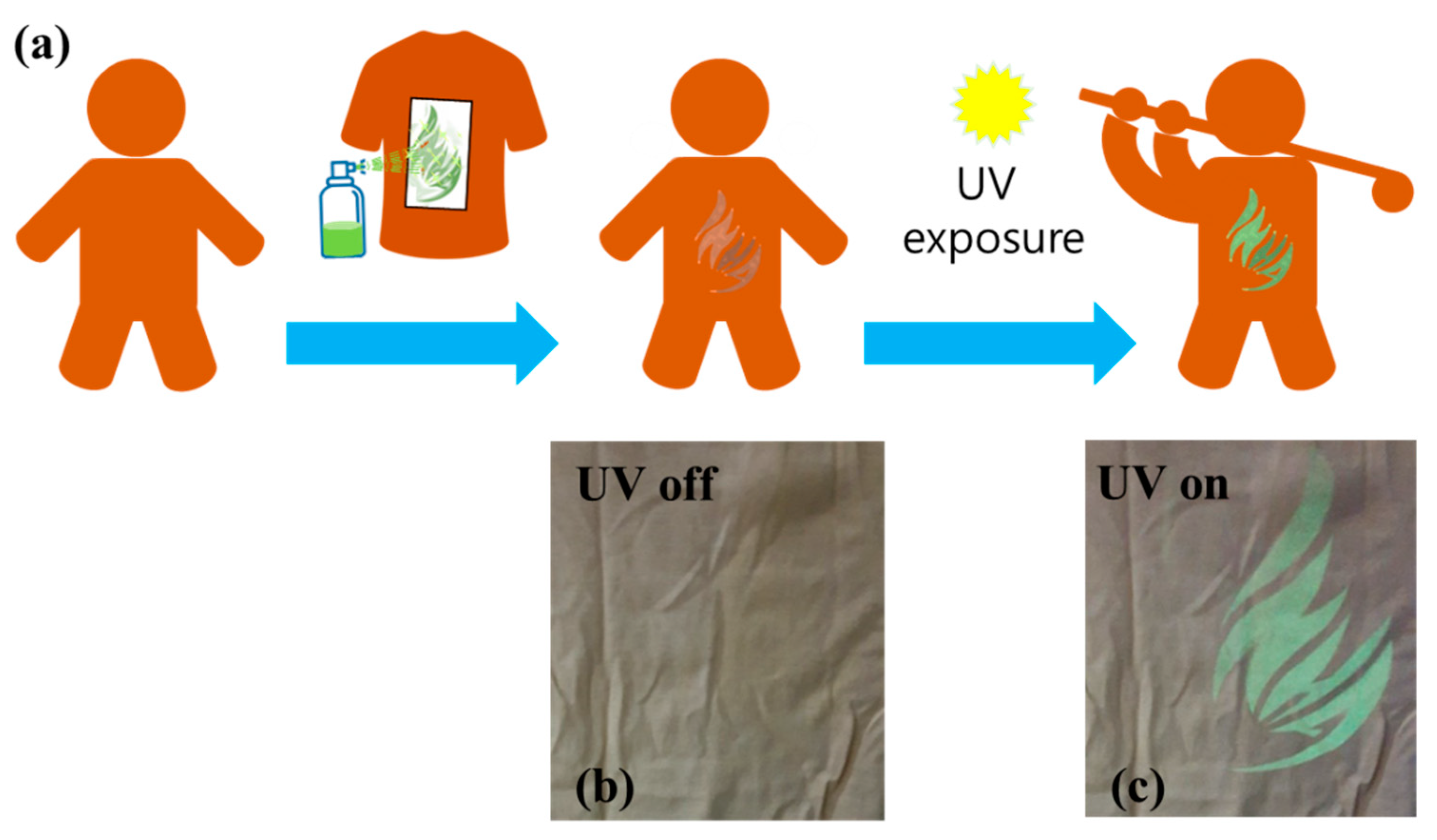Direct Visualization of UV-Light on Polymer Composite Films Consisting of Light Emitting Organic Micro Rods and Polydimethylsiloxane
Abstract
:1. Introduction
2. Materials and Methods
2.1. Experimentals
2.2. Measurements
3. Results and Discussion
3.1. Alq3 Miroc-Rods
3.2. Direct Visualization of UV Light Using Alq3 Miro-Rod and PDMS Composite Films
3.3. Demonstration of Direct UV Light Visuzlization Using Crystalline Alq3 Micro-Rods Printed T-Shirt Clothing
4. Conclusions
Author Contributions
Funding
Institutional Review Board Statement
Informed Consent Statement
Data Availability Statement
Conflicts of Interest
References
- Hou, Y.N.; Mei, Z.X.; Liang, H.L.; Ye, D.Q.; Liang, S.; Gu, C.Z.; Du, X.L. Comparative study of n-MgZnO/p-Si ultraviolet-B photodetector performance with different device structures. Appl. Phys. Lett. 2011, 98, 263501. [Google Scholar] [CrossRef] [Green Version]
- Zou, Y.; Zhang, Y.; Hu, Y.; Gu, H. Ultraviolet Detectors Based on Wide Bandgap Semiconductor Nanowire: A Review. Sensors 2018, 18, 2072. [Google Scholar] [CrossRef] [PubMed] [Green Version]
- Jheng, J.-S.; Wang, C.-K.; Chiou, Y.-Z.; Chang, S.-P.; Chang, S.-J. Voltage-Tunable UVC–UVB Dual-Band Metal–Semiconductor–Metal Photodetector Based on Ga2O3/MgZnO Heterostructure by RF Sputtering. Coatings 2020, 10, 994. [Google Scholar] [CrossRef]
- Zhou, H.; Song, Z.; Tao, P.; Lei, H.; Gui, P.; Mei, J.; Wang, H.; Fang, G. Self-powered, ultraviolet-visible perovskite photodetector based on TiO2 nanorods. RSC Adv. 2016, 6, 6205–6208. [Google Scholar] [CrossRef]
- Zeng, L.H.; Chen, Q.M.; Zhang, Z.X.; Wu, D.; Yuan, H.; Li, Y.Y.; Qarony, W.; Lau, S.P.; Luo, L.B.; Tsang, Y.H. Multilayered PdSe2/Perovskite Schottky Junction for Fast, Self-Powered, Polarization-Sensitive, Broadband Photodetectors, and Image Sensor Application. Adv. Sci. 2019, 6, 1901134. [Google Scholar] [CrossRef] [PubMed] [Green Version]
- Premi, S.; Wallisch, S.; Mano, C.M.; Weiner, A.B.; Bacchiocchi, A.; Wakamatsu, K.; Bechara, E.J.H.; Halaban, R.; Douki, T.; Brash, D.E. Chemiexcitation of melanin derivatives induces DNA photoproducts long after UV exposure. Science 2015, 347, 842–847. [Google Scholar] [CrossRef] [PubMed]
- Kang, C.H.; Dursun, I.; Liu, G.; Sinatra, L.; Sun, X.; Kong, M.; Pan, J.; Maity, P.; Ooi, E.N.; Ng, T.K.; et al. High-speed colour-converting photodetector with all-inorganic CsPbBr3 perovskite nanocrystals for ultraviolet light communication. Light Sci. Appl. 2019, 8, 94. [Google Scholar] [CrossRef]
- Kim, S.; Cui, C.; Huang, J.; Noh, H.; Park, D.H.; Ahn, D.J. Bio-Photonic Waveguide of a DNA-Hybrid Semiconductor Prismatic Hexagon. Adv. Mater. 2020, 32, 2005238. [Google Scholar] [CrossRef]
- Zheng, W.; Huang, F.; Zheng, R.; Wu, H. Low-Dimensional Structure Vacuum-Ultraviolet-Sensitive (λ < 200 nm) Photodetector with Fast-Response Speed Based on High-Quality AlN Micro/Nanowire. Adv. Mater. 2015, 27, 3921–3927. [Google Scholar]
- Zhao, L.; Gao, Z.; Zhang, J.; Lu, L.; Yu, W.; Hu, P.; Liang, J.; Zou, D. Enhancing electrical stability for flexible ZnO nanowire UV sensor by textured substrates. J. Mater. Sci. 2018, 53, 14172–14184. [Google Scholar] [CrossRef]
- Shi, L.; Nihtianov, S. Comparative Study of Silicon-Based Ultraviolet Photodetectors. IEEE Sens. J. 2012, 12, 2453–2459. [Google Scholar] [CrossRef]
- Yagi, S. Highly sensitive ultraviolet photodetectors based on Mg-doped hydrogenated GaN films grown at 380 °C. Appl. Phys. Lett. 2000, 76, 345–347. [Google Scholar] [CrossRef]
- Min, K.-P.; Kim, G.-W. Photo-Rheological Fluid-Based Colorimetric Ultraviolet Light Intensity Sensor. Sensors 2019, 19, 1128. [Google Scholar] [CrossRef] [PubMed] [Green Version]
- Ngampeungpis, W.; Tumcharern, G.; Pienpinijtham, P.; Sukwattanasinitt, M. Colorimetric UV sensors with tunable sensitivity from diacetylenes. Dyes Pigment. 2014, 101, 103–108. [Google Scholar] [CrossRef]
- Pankaew, A.; Traiphol, N.; Traiphol, R. Tuning the sensitivity of polydiacetylene-based colorimetric sensors to UV light and cationic surfactant by co-assembling with various polymers. Colloid Surf. A Physicochem. Eng. Asp. 2021, 608, 125626. [Google Scholar] [CrossRef]
- Shi, Y.; Manco, M.; Moyal, D.; Huppert, G.; Araki, H.; Banks, A.; Joshi, H.; McKenzie, R.; Seewald, A.; Griffin, G.; et al. Soft, stretchable, epidermal sensor with integrated electronics and photochemistry for measuring personal UV exposures. PLoS ONE 2018, 13, e0190233. [Google Scholar] [CrossRef] [Green Version]
- Tang, C.W.; Vanslyke, S.A. Organic electroluminescent diodes. Appl. Phys. Lett. 1987, 51, 913–915. [Google Scholar] [CrossRef]
- Yang, X.; Feng, X.; Xin, J.; Zhang, P.; Wang, H.; Yan, D. Highly efficient crystalline organic light-emitting diodes. J. Mater. Chem. C 2018, 6, 8879–8884. [Google Scholar] [CrossRef]
- Pérez-Bolívar, C.; Takizawa, S.Y.; Nishimura, G.; Montes, V.A.; Anzenbacher, P. High-Efficiency Tris(8-hydroxyquinoline)aluminum (Alq3) Complexes for Organic White-Light-Emitting Diodes and Solid-State Lighting. Chem. Eur. J. 2011, 17, 9076–9082. [Google Scholar] [CrossRef]
- Chen, W.; Peng, Q.; Li, Y. Alq3 Nanorods: Promising Building Blocks for Optical Devices. Adv. Mater. 2008, 20, 2747–2750. [Google Scholar] [CrossRef]
- Vivo, P.; Jukola, J.; Ojala, M.; Chukharev, V.; Lemmetyinen, H. Influence of Alq3/Au cathode on stability and efficiency of a layered organic solar cell in air. Sol. Energy Mater. Sol. Cells 2008, 92, 1416–1420. [Google Scholar] [CrossRef]
- Park, Y.-G.; Lee, S.; Park, J.-U. Recent Progress in Wireless Sensors for Wearable Electronics. Sensors 2019, 19, 4353. [Google Scholar] [CrossRef] [PubMed] [Green Version]
- Basir, A.; Alzahrani, H.; Sulaiman, K.; Muhammadsharif, F.F.; Alsoufi, M.S.; Bawazeer, T.M.; Sani, S.F.A. A study on optoelectronics and spectroscopic properties of TPD:Alq3 heterojunction films for the application of UV sensors. Physica B 2021, 600, 412546. [Google Scholar] [CrossRef]
- Kim, S.; Kim, D.H.; Choi, J.; Lee, H.; Kim, S.-Y.; Park, J.W.; Park, D.H. Growth and Brilliant Photo-Emission of Crystalline Hexagonal Column of Alq3 Microwires. Materials 2018, 11, 472. [Google Scholar] [CrossRef] [PubMed] [Green Version]
- Park, D.H.; Kim, M.S.; Joo, J. Hybrid nanostructures using π-conjugated polymers and nanoscale metals: Synthesis, characteristics, and optoelectronic applications. Chem. Soc. Rev. 2010, 39, 2439–2452. [Google Scholar] [CrossRef]




Publisher’s Note: MDPI stays neutral with regard to jurisdictional claims in published maps and institutional affiliations. |
© 2022 by the authors. Licensee MDPI, Basel, Switzerland. This article is an open access article distributed under the terms and conditions of the Creative Commons Attribution (CC BY) license (https://creativecommons.org/licenses/by/4.0/).
Share and Cite
Kim, M.; Kim, J.; Kim, H.; Jung, I.; Kwak, H.; Lee, G.S.; Na, Y.J.; Hong, Y.K.; Park, D.H.; Lee, K.-T. Direct Visualization of UV-Light on Polymer Composite Films Consisting of Light Emitting Organic Micro Rods and Polydimethylsiloxane. Polymers 2022, 14, 1846. https://doi.org/10.3390/polym14091846
Kim M, Kim J, Kim H, Jung I, Kwak H, Lee GS, Na YJ, Hong YK, Park DH, Lee K-T. Direct Visualization of UV-Light on Polymer Composite Films Consisting of Light Emitting Organic Micro Rods and Polydimethylsiloxane. Polymers. 2022; 14(9):1846. https://doi.org/10.3390/polym14091846
Chicago/Turabian StyleKim, Misuk, Jiyoun Kim, Hyeonwoo Kim, Incheol Jung, Hojae Kwak, Gil Sun Lee, Young Jun Na, Young Ki Hong, Dong Hyuk Park, and Kyu-Tae Lee. 2022. "Direct Visualization of UV-Light on Polymer Composite Films Consisting of Light Emitting Organic Micro Rods and Polydimethylsiloxane" Polymers 14, no. 9: 1846. https://doi.org/10.3390/polym14091846
APA StyleKim, M., Kim, J., Kim, H., Jung, I., Kwak, H., Lee, G. S., Na, Y. J., Hong, Y. K., Park, D. H., & Lee, K.-T. (2022). Direct Visualization of UV-Light on Polymer Composite Films Consisting of Light Emitting Organic Micro Rods and Polydimethylsiloxane. Polymers, 14(9), 1846. https://doi.org/10.3390/polym14091846






